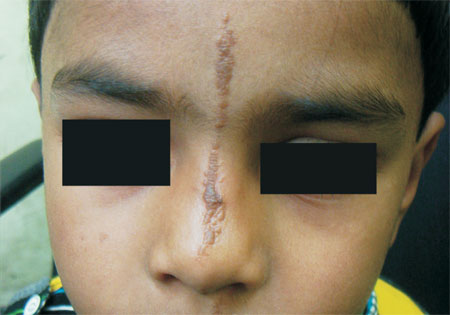A 4-year-old boy presented with a linear velvety brownish
plaque in the center of the nasal bridge extending slightly
on the forehead and slightly over the septal demarcation of
the nose (Fig. 1). It was present from
birth and increased in size as the age progressed. There was
no erythema or itching. A provisional diagnosis of linear
verrucous epidermal nevus was kept; epidermal
hyperkeratosis, acanthosis and papillomatosis were seen on
histopathology – consistent with the diagnosis of epidermal
nevus.
 |
|
Fig. 1 Linear non-epidermolytic
verrucous epidermal nervus.
|
Verrucous epidermal nevi are congenital,
non-inflammatory, cutaneous hamartomas composed of
keratinocytes. At birth they have a white, macerated
appearance but within a few days take the form of pink or
slightly pigmented, velvety streaks or plaques. Later, they
darken and become more warty, sometimes with an erythematous
base. They are distinct from inflammatory, acantholytic or
porokeratotic epidermal nevi, from sebaceous nevi, and from
epidermal nevi derived from skin appendages. Non-epidermolytic
verrucous epidermal nevi can be differentiated clinically
from other types as they are usually present at birth, and
are asymptomatic, non-inflammatory and persistent.

